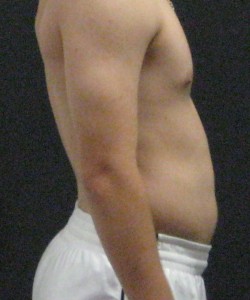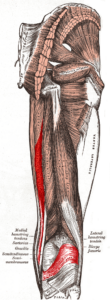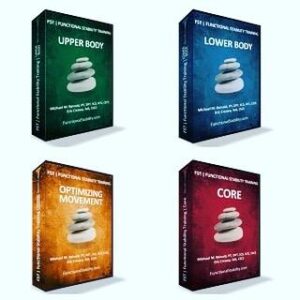
5 Reasons You Have Tight Hamstrings
There might not be a more obnoxious and stubborn athletic injury than the hamstrings strain. When it is really bad, it can bother you when you’re simply walking or sitting on it. Then, when a hamstrings strain finally feels like it’s getting better, you build up to near your top speed with sprinting – and it starts barking at you again. In other words, a pulled hamstrings is like a crazy, unpredictable mother-in-law; just when you think you’ve finally won her over, she brings you back down to Earth and reminds you how much more she liked your wife’s old boyfriend.
However, not all hamstrings pain cases are true strains; more commonly, they present as a feeling of “tight hamstrings.” If one is going to effective prevent this discomfort, rehabilitate it, or train around it, it’s important to realize what is causing the hamstrings tightness in the first place. Here are five reasons:
1. Protective Tension of the Hamstrings
This is readily apparent in someone who has a crazy anterior pelvic tilt, which puts a big stretch on the hamstrings, which posteriorly tilt the pelvis. When someone is extremely anteriorly tilted, the hamstrings are constantly “on” to prevent someone from ending up with extension-based back pain, such as spondylolysis (vertebral fractures), spondylolisthesis (vertebral “slippage”), and lumbar erector tightness/strains. This is a problem most commonly seen in females (greater anterior pelvic tilt than men) and athletes:

Doing a lot of longer duration static stretching for the hamstrings in this population usually isn’t a great idea, as you run the risk of making someone more unstable – particularly in the case of females, who have less rigid ligamentous restraints (more congenital laxity) to protect them. To that end, our approach with these folks is to use the warm-ups to foam roll the area, then do some hamstrings mobilizations to transiently reduce stiffness in the hamstrings.
After this reduction in stiffness, we work to build stability in synergists to the hamstrings in posterior pelvic tilt. In other words, there’s a heavy emphasis on glute activation and anterior core recruitment both with a strength training program and postural reeducation for the other 23 hours of the day.
At the end of the training session, with the male athletes, we may do some shorter duration hamstrings stretching just to “dissipate” a little eccentric stress.
The thing to remember is that while you can do everything right with these athletes in training, what they do with their posture during the rest of their lives is of paramount importance. If they continue to stand around in anterior tilt and don’t help the new stiffness they’ve developed “stick,” they’ll continue to over-rely on their already tight hamstrings.
2. Neural Tension
Just because you feel hamstrings tightness doesn’t mean that the hamstrings are actually the source of the problem. In fact, it’s not uncommon at all for those with lumbar disc issues to present with radicular pain, tightness, or numbness/tingling into the legs – especially the hamstrings. The symptoms may also come from nerve entrapment (most commonly the sciatic nerve) on soft tissue structures further down the chain. Just aggressively stretching the hamstrings can actually make these symptoms worse, so it’s important to see a medical professional to rule out causes further up with the appropriate clinical exams, such as the slump test.
3. Truly Tight Hamstrings
In order for hamstrings to really be short, one would have to spend a lot of time with the knee flexed and hip extended – so just imagine the position you’re in at the top of a standing leg curl. That’s a hard pose to hold for an extended period of time, much less do so on a regular basis.
That said, some folks do get somewhat close to that on a daily basis in the sitting position, and are therefore the most likely to really have “tight hamstrings.” They have to be in posterior pelvic tilt and knee flexion for a considerable chunk of the day – and even then, it’s still pretty tough to be truly short, as they are still in hip flexion.
These folks usually can’t distinguish hip flexion from lumbar flexion, so if you do a standing hip flexion assessment, rather than maintain the neutral spine we see in this photo, they’ll go into lumbar flexion (butt will “tuck under”).
The same trend will usually be noticeable with any kind of squat unless they have a tremendous amount of core stiffness to overcome the posterior hip stiffness that’s present. If you test these folks on an straight leg raise, it isn’t pretty, as the pelvis is already posteriorly tilted. In a pelvis that starts in “neutral” on a straight leg raise, roughly the first 1/3 of movement that you see comes from posterior tilt of the pelvis before the femur ever starts to flex on the acetabulum of the pelvis. These folks are usually already posteriorly tilt, so that 1/3 is already used up; you’re really only measuring hip flexion and not hip flexion PLUS posterior pelvic tilt. And, as you can imagine, if someone is truly short in the hamstrings, that straight leg raise isn’t going to be pretty. Obviously, these folks usually have a terrible toe touch pattern as well.
This should also educate you on why you can’t treat all hamstrings strains the same. In the protective tension example earlier, we needed to work to regain stability to hold a position of a bit more posterior pelvic tilt. We’d cue glute activation, and use exercises that draw folks back into posterior tilt (e.g., reverse crunches). If you have someone has a pulled hamstrings because they are truly short from already being in posterior pelvic tilt, though, some of these cues and exercises would be contraindicated. You’d be feeding the dysfunction.
While manual therapy and stretching for the posterior hip is valuable, again, it must be followed by stabilization work at adjacent joints with the pelvis in a neutral position. These folks can benefit from training hip flexion above 90 degrees as well, as it educates them on how to flex the hip without rounding the lumbar spine. This is one reason why I think a lot of the chop and lift exercises we’ve learned from Gray Cook are so fantastic; they teach us anti-rotation and anti-extension stability in various positions of hip flexion while the pelvis is in neutral. They make changes “stick” better.
4. Previous Hamstrings Strain
Not to be overlooked in this discussion is the simple fact that the single-best predictor of hamstrings strains is a previous hamstrings injury. One you have an injury, that area may never be the same from a tissue density standpoint – whether it’s the surrounding fascia or the muscle or tendon itself. A previous injury can leave athletes feeling “tight” in the region, so regular manual therapy can certainly help in this regard.
Anecdotally, the athletes with the long-term problems seem to be the ones with the pulls up on the gluteal fold, right where the hamstrings tendons attach to the ischial tuberosity. The area gets “gunked up”in a lot of athletes as it is because of all the tissues coming together and exerting force in a small area, but it’s especially problematic in those who have a previous injury in the region. Perhaps more problematic, though, is the fact that we sit on our proximal hamstrings attachments – and that isn’t exactly good for blood flow and tissue regeneration.

I haven’t seen any research on it, but I have a feeling that if you looked at this region in a lot athletes with ultrasound (similar to this study with patellar tendons), you’d find a ton of people walking around with substantial degenerative changes that could be diagnosed as tendinosis even though they haven’t actually hit a symptomatic threshold. My guess is that it’s even worse in the posterior hip region because a) we sit on it, b) the ischial tuberosity is a more “congested” area than the anterior knee), and c) the study I noted above used 14-18 year-old athletes, and degenerative problems will get worse as one gets older (meaning this study likely undercut the true prevalence across the entire population).
Very simply, an athlete with a previous hamstrings strain needs to stay on top of quality manual therapy on the area, and be cognizant of maintaining mobility and stability in the right places. They have less wiggle room with which to work.
5. Acute Hamstrings Strain or Tendinosis
Of course, the fifth reason you hamstrings might be tight is because you might actually have a hamstrings injury! It could be an actual hamstrings strain, or just a tendinosis (overuse issue where tissue loading exceeds tissue tolerance for loading). There is no one perfect recommendation in this regard, as a tendinosis or grade 1 hamstrings strain is going to be much more tolerable than a grade 3 hamstrings strain where you have bruising all along the back of your thigh.
In terms of maintaining a training effect with the less serious ones, here are a few suggestions:
a. When you are ready to deadlift, use trap bar deadlifts instead of conventional or sumo deadlift variations. I explain a bit more about how the positioning of the center of gravity makes this more hamstrings friendly HERE.
b. Shorten up your stride on single-leg exercises. This makes the movement slightly more quad dominant, but allows you to still get the benefits of controlling the frontal and transverse planes with appropriate glute and adductor recruitment at the hip.
c. Go with step-up and reverse sled dragging variations. Eliminating the eccentric component can take a considerably amount of stress off the hamstrings, and both these exercises get the job done well.
d. If you’re going to squat, start with front squats at the beginning, and reintegrate back squat and box squat variations later on, as they will be more hamstrings intensive.
e. Understand anatomy. If you are in hip flexion and knee extension, you’re going to really be stretching the hamstrings and likely irritating them in the process. Select exercises that don’t hit these painful end-ranges, and then gradually reintroduce more dramatic ranges of motion as the issues subside.
f. Do hill sprints before you do regular sprints. Your stride is going to be a bit shorter with hill sprints, and that’ll take a considerable amount of stress off the hamstrings at heel strike (pretty good research on uphill vs. downhill sprinting HERE, for those who are interested). Just don’t go out and run as hard as you can the first time out; propulsive forces are still quite high.
Of course, this just speaks to how to train around a pulled hamstrings; there is really a lot more to look at if you want to really understand why they occur and how to prevent or address them. In my eyes, this post was necessarily “geeky,” as it is important that we don’t dumb down complex injuries to “just stretch it out.” This recommendation is analogous to a doctor just telling someone to take some NSAIDs for regular headaches; it doesn’t get to the root of the problem, and it may actually make things worse.
For more information, I’d encourage you to check out the Functional Stability Training series.




